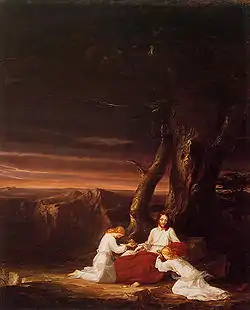Matthew 4:11
Matthew 4:11 is the eleventh verse of the fourth chapter of the Gospel of Matthew in the New Testament. Jesus has just rebuffed Satan's third temptation and ordered him away. In this last verse of the temptation scene the devil departs and Jesus is serviced by angels.
| Matthew 4:11 | |
|---|---|
← 4:10 4:12 → | |
 Thomas Cole's Angels Ministering to Christ in the Wilderness. | |
| Book | Gospel of Matthew |
| Christian Bible part | New Testament |
Content
The text in Koine Greek, according to the Textus Receptus and Westcott and Hort, reads:[1]
- Τότε ἀφίησιν αὐτὸν ὁ διάβολος καὶ ἰδού ἄγγελοι προσῆλθον καὶ διηκόνουν αὐτῷ
In the King James Version of the Bible the text reads:
- Then the devil leaveth him, and, behold,
- angels came and ministered unto him.
The English Standard Version translates the passage as:
- Then the devil left him, and behold,
- angels came and were ministering to him.
For a collection of other versions see BibleHub Matthew 4:11.
Analysis
In the original Greek "devil left him" was in the historic present tense. This indicates that the devil had not left for good and would later return to further tempt Jesus. Luke 4:13 makes this explicit stating that the devil left only to await a more opportune time.[2]
The angels are mentioned in the Gospel of Mark at Mark 1:13 but they are absent from Luke's narrative. As described in Matthew 4:2 Jesus had been fasting for forty days and nights prior to the temptation. The word minister or served is often interpreted as the angels feeding Jesus. France states that this seems to reference 1 Kings 19:5-8 where the prophet Elijah is fed by angels.[3] Traditionally artists have depicted the scene as Jesus being presented with a feast. John Milton in Paradise Regained has a detailed description of the feast the angels present to Jesus. Clarke notes that ending the temptation narrative with a meal reflects the common literary device of using a feast scene to emphasize a happy ending. That the divine angels provide Jesus with the food is a clear sign that it is acceptable for him to break his fast.[4] To Jones the divine relief is proof that Jesus was never wrong because he never lost his faith in God during the temptation scene.[5] Hill notes that in the War Scroll found at Qumran angels are described as forming an army to battle evil. This is somewhat at odds with the portrayal of angels in the gospels, but could in theory be linked to this verse with the angels actually aiding in driving off Satan rather than simply ministering to Jesus.[6]
Textual witnesses
Some early manuscripts containing the text of this verse are:
- Papyrus 102 (3rd century)[7][8]
- Codex Vaticanus (325-350)
- Codex Sinaiticus (330-360)
- Codex Bezae (~400)
- Codex Washingtonianus (~400)
- Codex Ephraemi Rescriptus (~450)
References
- Greek Text Analysis: Matthew 4:11. Biblehub
- Albright, W.F. and C.S. Mann. "Matthew." The Anchor Bible Series. New York: Doubleday & Company, 1971.
- France, R.T. The Gospel According to Matthew: an Introduction and Commentary. Leicester: Inter-Varsity, 1985.
- Clarke, Howard W. The Gospel of Matthew and its Readers: A Historical Introduction to the First Gospel. Bloomington: Indiana University Press, 2003.
- Jones, Alexander. The Gospel According to St. Matthew. London: Geoffrey Chapman, 1965.
- Hill, David. The Gospel of Matthew. Grand Rapids: Eerdmans, 1981
- Thomas, J. David. The Oxyrhynchus Papyri LXIV (London: 1997), pp. 4–5.
- "Liste Handschriften". Münster: Institute for New Testament Textual Research. Retrieved 27 August 2011.
| Preceded by Matthew 4:10 |
Gospel of Matthew Chapter 4 |
Succeeded by Matthew 4:12 |